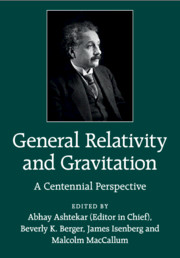Book contents
- Frontmatter
- Contents
- Preface
- List of contributors
- List of figures
- List of tables
- Part One Einstein's Triumph
- Part Two New Window on the Universe: Gravitational Waves
- Part Three Gravity is Geometry, after all
- Part Four Beyond Einstein
- 10 Quantum Fields in Curved Spacetime
- 11 From General Relativity to Quantum Gravity
- 12 Quantum Gravity via Supersymmetry and Holography
- Index
- References
12 - Quantum Gravity via Supersymmetry and Holography
from Part Four - Beyond Einstein
Published online by Cambridge University Press: 05 June 2015
- Frontmatter
- Contents
- Preface
- List of contributors
- List of figures
- List of tables
- Part One Einstein's Triumph
- Part Two New Window on the Universe: Gravitational Waves
- Part Three Gravity is Geometry, after all
- Part Four Beyond Einstein
- 10 Quantum Fields in Curved Spacetime
- 11 From General Relativity to Quantum Gravity
- 12 Quantum Gravity via Supersymmetry and Holography
- Index
- References
Summary
This chapter offers a survey of ideas and results in the approach to quantum gravity based on supersymmetry, strings, and holography.
Extra spatial dimensions appear naturally in this approach, so to set the stage we begin in Section 12.1 with a discussion of general relativity in more than four spacetime dimensions. In higher dimensions, one encounters a richness of structure with no parallel in 4D. Even in vacuum gravity, this includes black hole solutions with non-spherical horizon topologies, black hole non-uniqueness, and regular multi-horizon black holes. We give an overview of such solutions and their properties, both in the context of Kaluza–Klein theory and for asymptotically flat boundary conditions.
A very interesting extension of general relativity is to include matter in such a way that the action becomes invariant under supersymmetry transformations. Supersymmetry is a remarkable symmetry that relates bosons and fermions. It is the only possible extension of the Poincaré group for a unitary theory with non-trivial scattering processes. Supersymmetry is considered a natural extension of the standard model of particle physics; the study of how supersymmetry is broken at low energies, and its possible experimental consequences, is an important active research area in particle physics. Furthermore, independently of its potential phenomenology, supersymmetry offers strong calculational control and that makes it a tremendously powerful tool for analyzing fundamental properties of quantum field theories.
When supersymmetry and general relativity are combined, the result is supergravity. The metric field is accompanied by a spin-3/2 spinor field and this gives a beautiful and enticing playground for advancing our understanding of quantum gravity. Supergravity theories exist in spacetime dimensions D ≤ 11 and they provide a natural setting for studies of charged black holes. Certain extremal limits of charged black holes in super-gravity are invariant under supersymmetry; such ‘supersymmetric black holes’ are key for understanding the statistical mechanical nature of black hole thermodynamics, specifically the microstates responsible for the Hawking–Bekenstein entropy. An example of a super- symmetric black hole is the extremal Reissner–Nordström solution.
- Type
- Chapter
- Information
- General Relativity and GravitationA Centennial Perspective, pp. 612 - 666Publisher: Cambridge University PressPrint publication year: 2015



